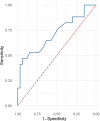Promoting medication compliance in epileptic children: a cross sectional survey
- PMID: 39277767
- PMCID: PMC11401307
- DOI: 10.1186/s12887-024-05011-7
Promoting medication compliance in epileptic children: a cross sectional survey
Abstract
Background: Compliance with medication is crucial for the favorable prognosis of children with epilepsy. The objective of this study was to assess the determinants of medication compliance and to construct a predictive model for the risk of non-compliance among pediatric epilepsy patients.
Methods: The study included children diagnosed with epilepsy and treated at our hospital between February 1 and September 30, 2023. We evaluated the demographic characteristics and medication compliance profiles of these patients. The predictive model's performance was assessed using the receiver operating characteristic (ROC) curve to determine its sensitivity and specificity.
Results: A total of 168 children with epilepsy were analyzed. The rate of non-compliance with medication was found to be 32.74% (55 out of 168). Logistic regression identified the educational level of parents (OR = 2.844, 95% CI: 2.182-3.214), monthly household income (OR = 1.945, 95% CI: 1.203-2.422), the number of medications taken (OR = 1.883, 95% CI: 1.314-2.201), and the level of epilepsy knowledge received (OR = 2.517, 95% CI: 1.852-3.009) as significant factors influencing non-compliance (all p < 0.05). A total score threshold of 6 was set for the predictive model. The area under the ROC curve was 0.713 (95% CI: 0.686-0.751), indicating the model's discriminative ability.
Conclusions: The compliance to medication regimens among children with epilepsy is suboptimal and influenced by a multitude of factors. This study has developed a predictive model for medication compliance, which could serve as a valuable tool for clinical assessment and intervention planning regarding medication compliance in pediatric epilepsy patients.
Keywords: Care; Children; Compliance; Epilepsy; Nursing; Treatment.
© 2024. The Author(s).
Conflict of interest statement
The authors declare no competing interests.
Figures
Similar articles
-
Medication compliance of children with epilepsy: a cross-sectional survey.Ital J Pediatr. 2023 Nov 16;49(1):153. doi: 10.1186/s13052-023-01525-5. Ital J Pediatr. 2023. PMID: 37974267 Free PMC article.
-
A cross-sectional study on the rate of non-adherence to anti-seizure medications and factors associated with non-adherence among patients with epilepsy.PLoS One. 2020 Jul 10;15(7):e0235674. doi: 10.1371/journal.pone.0235674. eCollection 2020. PLoS One. 2020. PMID: 32649723 Free PMC article.
-
Antiepileptic drug adherence in children in southern Ethiopia: A cross sectional study.PLoS One. 2022 Feb 17;17(2):e0263821. doi: 10.1371/journal.pone.0263821. eCollection 2022. PLoS One. 2022. PMID: 35176045 Free PMC article.
-
Compliance in children and adults: review of studies.Epilepsy Res Suppl. 1988;1:23-47. Epilepsy Res Suppl. 1988. PMID: 3072190 Review.
-
Interventions to promote medication adherence among children with epilepsy: An integrative review.J Pediatr Nurs. 2024 Sep-Oct;78:e51-e58. doi: 10.1016/j.pedn.2024.06.015. Epub 2024 Jun 29. J Pediatr Nurs. 2024. PMID: 38944619 Review.
References
-
- Ngarka L, Siewe Fodjo JN, Ambomatei C, Njamnshi WY, Taryunyu Njamnshi JN, Nfor LN, Mengnjo MK, Njamnshi AK. Epidemiology of epilepsy and relationship with onchocerciasis prevalence in villages of the Ntui Health District of Cameroon. Epilepsy Behav. 2023;142:109184. 10.1016/j.yebeh.2023.109184 - DOI - PMC - PubMed
MeSH terms
Substances
LinkOut - more resources
Full Text Sources
Medical


